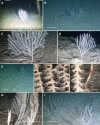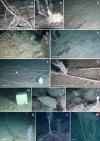Healthy assemblages of Isidella elongata unintentionally protected from trawling offshore of Asinara Island (northwestern Sardinia, NW Mediterranean Sea)
- PMID: 38834719
- PMCID: PMC11150251
- DOI: 10.1038/s41598-024-63652-1
Healthy assemblages of Isidella elongata unintentionally protected from trawling offshore of Asinara Island (northwestern Sardinia, NW Mediterranean Sea)
Abstract
Deep-sea coral assemblages are marine biodiversity hot spots. Because of their life history traits, deep-sea corals are highly vulnerable to the impacts of human activities such as fishing. The critically endangered "bamboo coral" Isidella elongata is a key structuring species of deep muddy bottoms that is susceptible to habitat destruction, particularly from trawling. A shallow population of this species was recently discovered by a multibeam and ROV survey offshore of the Asinara Island marine protected area (MPA) (northwestern Sardinia, NW Mediterranean Sea). This vulnerable marine assemblage has been found under healthy conditions at depths ranging from 110 to 298 m. Isidella elongata occurs on a muddy seafloor locally characterised by boulders associated with black coral species (Parantipathes larix and Antipathes dichotoma). The lush colonies of I. elongata seem to be related to natural protection from bottom trawling activity; nevertheless, the presence of lost fishing artisanal nets has been observed in the study area. These structuring species are indicators of vulnerable marine ecosystems, and their conservation is essential for preserving marine biodiversity. Therefore, enlarging the perimeter of the Asinara Island MPA into its deeper western waters is suggested to ensure the protection of these valuable and vulnerable marine ecosystems.
© 2024. The Author(s).
Conflict of interest statement
The authors declare no competing interests.
Figures










References
-
- Grasshoff M. Die Gorgonaria der expeditionen von Travailleur 1880–1882 und Talisman 1883 (Cnidaria, Anthozoa) Zoosystema. 1988;8:9–38.
-
- Grasshoff M. The straits of Gibraltar as a faunistic barrier: The gorgonaceans, pennatulaceans, and antipatharians of the BALGIM cruise (Cnidaria: anthozoa) Senckenberg Marit. 1989;20(5–6):201–223.
-
- Cartes JE, Lo Iacono C, Mamouridis V, López-Pérez C, Rodríguez P. Geomorphological, trophic and human influences on the bamboo coral Isidella elongata assemblages in the deep Mediterranean: To what extent does Isidella form habitat for fish and invertebrates? Deep-Sea Res. 2013;I(76):52–65. doi: 10.1016/j.dsr.2013.01.006. - DOI
-
- Chimienti G, Bo M, Taviani M, Mastrototaro F. 19: Occurrence and biogeography of Mediterranean cold-water corals. In: Orejas C, Jiménez C, editors. Mediterranean Cold-Water Corals: Past, Present and Future. Springer; 2019. pp. 213–243.
-
- Fabri MC, et al. Megafauna of vulnerable marine ecosystems in French Mediterranean submarine canyons: Spatial distribution and anthropogenic impacts. Deep Sea Res. II Top. Stud. Oceanogr. 2014;104:184–207. doi: 10.1016/j.dsr2.2013.06.016. - DOI
MeSH terms
LinkOut - more resources
Full Text Sources

